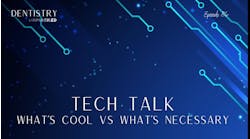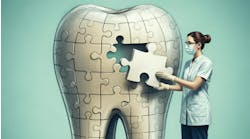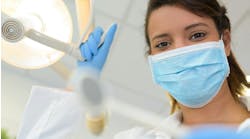by John Jameson
Featuring Brian Peterson and Patrick McGibbon of Dentrix and Kimberly Goodson and Mike Reeves of PerioPal
Dr. John H. Jameson speaks with Dentrix and PerioPal experts about voice-activated charting technologies, which he describes as "one of the hottest technologies available that some practices have had positive results with and others are still questioning."
Dr. Jameson: The utilization of voice in activation and record keeping has been around through several generations of evolving technology. What are your perspectives on the clinical and financial benefits of a practice proceeding with this state-of-the-art standardized type of data gathering?
Kimberly/PerioPal: As we interviewed hygienists all across the nation, we first tried to identify what they liked and didn't like about doing periodontal exams. We learned that clinicians wanted periodontal exams to be efficient and less expensive. They wanted to be able to work alone, to share exam results with patients, to increase the frequency of exams, and decrease their professional liability. Using voice command, the clinician is now able to be self sufficient in charting, performing the exam alone, having a shortened enrollment time of periodontal data and even increasing the accuracy of the exam with reduced repetitive clinical charting. This allows for more productive time with the patient, decreases overhead and therefore increases office productivity.
Mike/PerioPal: Timingwise, in the dental field, they've only recently come out with proper insurance codes for filing periodontal exams separately from other dental procedures. This increases the probability for the insurance companies to cover the expenses. Very few procedures in medicine allow a patient to walk away with a tangible piece of evidence. For years, it's been the minimal prescription given to the patient that was the tangible evidence that they'd been to the doctor and had treatment. With a voice-activated chart from the periodontal exam and the reports that now indicate where the patient is having specific periodontal problems, patients can walk out with a piece of tangible evidence that they've received healthcare from the dentist. This is not only educational, but encourages patients to return for diagnosed treatment. The ideal situation would be for a dentist to do a single pass through the full mouth and record everything that's necessary from a periodontal examination standpoint (type of tooth, any abnormalities or at least any area of additional inspection needed) in approximately eight minutes.
Brian/Dentrix: The added efficiency for the office is outstanding. Typically, when a hygienist is taking perio notes, they're calling them out to an assistant who is recording them. There's obviously a chance for human error here, but also two individuals are needed during that process. This technology allows the hygienist to simply call out that probing depth which is then automatically recorded into the software without a chance for error. Meanwhile, the assistant is doing something more productive in other areas of the practice. Actually, we've seen a lot of offices where the hygienist is probing and recording alone, so this voice activation helps save substantial amounts of time in that office. This also absolutely helps control infection and cross-contamination problems.
Dr. Jameson: The entire record then, through computerized, voice-activated periodontal charting, can make a much more effective and finite result for patients to see as they decide to proceed. Do you have any records about that suggested productivity increase?
Kimberly/PerioPal: We're still in data testing, but everything I've read so far says, after a comprehensive exam, 10 percent of existing patients will need scaling/root planing; 15 percent will need medication and 25 percent will need periodontal maintenance. Also, 50 to 60 percent of new adult patients have some form of periodontal disease needing at least two quads of scaling/root planing.
Brian/Dentrix: One of the benefits that may be largely overlooked and is definitely difficult to measure, is the enhancement of the practice's professional image. "My dentist uses voice-recognition technology to input their clinical data and give me something I can understand,"—well, that's a huge advantage for that practice, in the area of advancing their professional image. I also think, as far as additional profitability, if you look at voice recognition and the time saved through greater efficiency and proficiency with this technology, you're literally adding appointment slots per day onto the production of the practice so there's obviously a profitability return there. This provides for a tremendous change in the utilization of staff, which makes the practice more profitable. It's hard to measure exactly because if you've traditionally had a hygienist and an assistant to do a perio exam and now that assistant is freed up, your gain is two-fold: increased efficiency during that exam and in the area of the practice on which that assistant is now able to focus. Image enhancement, clinical efficiency, better team member time management: that sums it up.
Dr. Jameson: What is the difficulty of training this software to respond accurately to a person's voice and what is the timeframe one should expect before implementing this into the practice?
Patrick/Dentrix: In regards to the accuracy, after the first voice training session, which is generally anywhere from 10 to 15 minutes of reading, the system begins to pick up the way that a certain person says particular words. It creates the voice profile and enhances the accuracy of the software. Just after that initial training session has been done, we can achieve 90 to 95 percent accuracy! However, we do suggest additional training up to about one hour per individual using the system, just to bring that accuracy rate up to the perfect standard each practice is hoping for. In the past, because it was a hardware-based technology, these trainings took one to two hours before the most simple commands could be recognized. Now, it's software-based and therefore able to recognize nearly all commands in just minutes. Also, background noise interference used to be a common concern. Now, the software works extremely well in spite of such noisy environments, having a high success rate even on a loud tradeshow floor where the software is being demonstrated. So, while there's still potential for that interruption, it's far improved from the past.
Brian/Dentrix: There are several keys to success we use to help ensure the greatest result. First, you need to learn the voice commands. Just as you'd need to know where to click your mouse, you need to know what voice commands will accomplish a certain task. Second, involve the clinical staff in the implementation process. As with any technology that's added to a dental office, the staff needs to be on board with the direction the office is going. Third, speak clearly. Remember that you're talking to a computer, so deliberate, clear speech will make the technology work well. Lastly, be familiar with the Dentrix patient and perio charts. It works best if you've been using these charts before implementing the voice activation software.
Dr. Jameson: As we think about the kinds of products that are on the market, whether as a stand-alone product not integrated into a major national software—or looking at it from the other direction—how does the voice-activation system connect with the patient chart? Can it be bridged with the patient record?
Mike/PerioPal: We designed an interface that makes it extremely easy for any dental software vendor to have perio exams. All they need to do is select the patient, and hit a button to the application they're interested in. This passes the name of the patient, birth date, medical chart number and ID number into their application. It's like a single call to the PerioPal program, which bypasses its own demographic information and calls up the exam for that patient, storing all of this information in with each patient for each exam.
Patrick/Dentrix: It interfaces with the Dentrix patient chart in the practice management software including existing conditions, completed treatment procedures and treatment plans for future work. All of that can be done with the voice command recognition, accomplishing virtually anything the mouse would in that module. That also holds true for voice activation with the perio chart – acting the same way the mouse would. Dictation, on the other hand, is used primarily for clinical notes. However, it can be used anywhere the keyboard would normally be used. So, to summarize, yes, it's seamless vertical integration: periodontal charting software functions as the mouse would and the doctor/chart notes function where the keyboard would – all straight into the patient chart.
Dr. Jameson: As dentists are able to do this, what result do you anticipate occurring in the eyes of the patient family at these state-of-the-art practices?
Kimberly/PerioPal: In my experience, when you finish recording a periodontal exam, the patient has already diagnosed themselves. Co-diagnosis requires very little additional education. Clinicians can give a little background about the program before they begin, perform the exam, and by the time they're finished, the patient already knows whether they have disease or not. For example, one of our voice commands is "Normal." If all three sites are within the normal range, instead of saying 2 -1- 2, you simply say "Normal." PerioPal records the data and automatically advances. When the patients don't hear "Normal," but instead hear different data being recorded, they know they have disease activity. They often question the clinician who can use their report and its trigger points to show disease or healthy areas. They have a much better understanding of their overall oral health status. Records are stored and are easy to access when you have future evaluations and want to make comparisons with previous and/or existing conditions.
Dr. Jameson: PerioPal is a stand-alone unit that can be bridged to the patient records in their management file. As you're working with that product to determine existing conditions and analyze future conditions, what kind of research and development are you in the process of establishing to make that happen?
Mike/PerioPal: We have two different things in the works. The first is a comparative report to allow everyone to see the changes that have occurred from one period to the next. The second is a treatment outcome routine so that, like the comparative report, the treatment will allow the hygienist or dentist to record which teeth are treated and how. This allows you to have an outcome analysis of what's going on in the mouth periodontally. It's just a one- touch, one-glance report that's easy to understand.
Dr. Jameson: What do you see as the next stage of voice activation to be implemented into the practice?
Brian/Dentrix: As we consider that and look at the possibilities of what could be done going forward, there's a whole gamut of possibilities. Our next natural progression may be voice commands in the imaging realm of our software. I'm not aware, however, of any immediate plans to incorporate this additional functionality. On an interesting side note, one of the hot topics at our most recent technology summit seemed to indicate great interest in voice recognition/commands for the entire operating system.
Brian K. Peterson is the High-Tech National Sales Manager for Dentrix Dental Systems, Inc. Brian graduated from the University of Utah in 1991 and has worked for Dentrix Dental Systems for more than five years. Brian plays a key role in leading the Dentrix sales force, managing the sales of multiple high-tech products, and is influential in new product roll-outs. Brian is married and has three children.
Patrick D. McGibbon is the National Sales Trainer for Dentrix Dental Systems, Inc. Patrick received his bachelor's degree from Brigham Young University in 1998. Patrick currently plays an instrumental role in educating and training the Dentrix and Sullivan Schein sales forces. Patrick has been with Dentrix for more than five years.
Mike Reeves is a system developer of PerioPal and a medical management industry veteran with roots in defining the medical software revolution that began in the mid-1970s. Prior to developing PerioPal, Reeves spent 25 years as CEO of MedsAmerica, Inc. designing CMEDS, a complete medical practice administration system used by over 3,000 physicians. He also designed and programmed the AmeriClaims Ltd. claims forwarding system for claims submission to NEIC, Medicare, Medicaid, Champus and others. Reeves then integrated AmeriClaims with MedsAmerica's CMEDS software, offering physicians a complete medical management solution. [email protected]
Kimberly Goodson graduated from Caruth School of Dental Hygiene, Baylor College of Dentistry in 1976 with a degree in Dental Hygiene. Goodson, an ADHA member, is responsible for extending the company's Patient Education strategy, managing strategic partnerships, and overseeing legal, sales, financial and business development activities. Goodson resides in Beaumont, Texas, where she is a practicing registered dental hygienist. [email protected].
Dr. John Jameson is Chairman of the Board for Jameson Management, Inc., an international dental consulting firm. Representing JMI, he writes for numerous dental publications and provides research for manufacturers and marketing companies, as well as lecturing worldwide on the integration of technology into the dental practice, and leadership. He also manages the technology phase of the consulting program carried out by JMI consultants in the United States, Canada, and Europe. He may be reached at (877) 369-5558 or by visiting www.jamesonmanagement.com.





